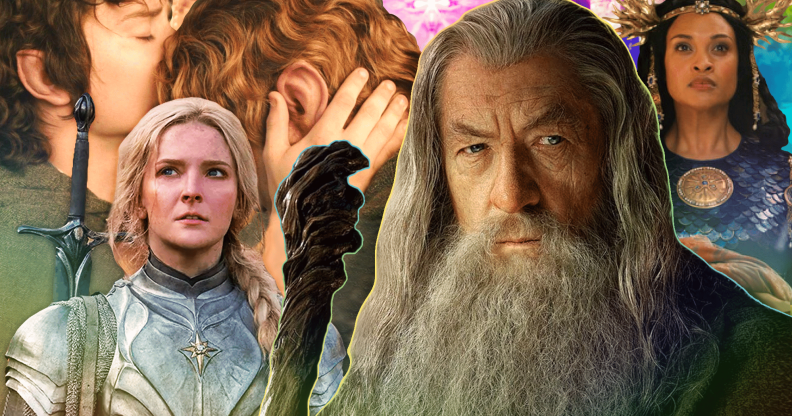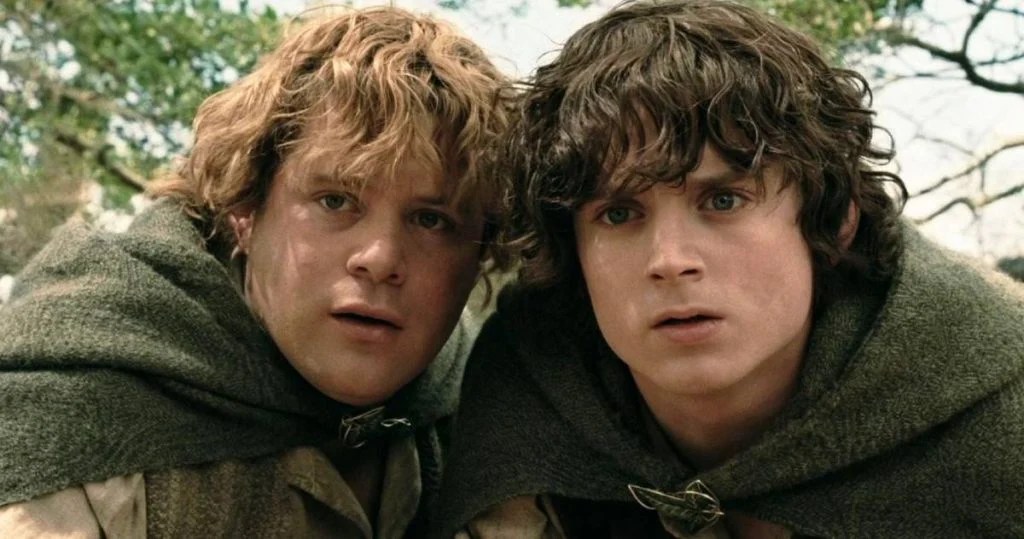The very, very queer history of Lord of the Rings – from Gandalf’s sexuality to Frodo and Sam

The Lord of the Rings. (New Line Cinema / Amazon Studios)
Almost 70 years after JRR Tolkein published the first in his Lord of the Rings epic fantasy trilogy – a new vision of Middle Earth has finally arrived on our screens.
And as Amazon Prime drops its highly anticipated prequel series Lord of the Rings: Rings of Power, now feels like the perfect time to look back at the queer history of the series.
Of course, as with any other hugely popular fiction series, there is a rich LGBTQ+ fanbase that has lifted the subtext of the novels to create hugely popular queer readings of Middle Earth.
The queer subtext of the series has been around since the beginning, with Scottish poet Edwin Muir heavily criticising Tolkien for his writing of men where “hardly one of them knows anything about women”.
Meanwhile, openly gay poet WH Auden, once said: “No fiction I have read in the last five years has given me more joy.”
As one of the most influential fantasy texts of the 20th century, literary analysis has dug deep and found rich LGBTQ+ representation and metaphor.
In 2021 the Tolkien Society put on a controversial set of talks exploring queerness in Tolkien’s work including one talk called: Gondor in Transition: A Brief Introduction to Transgender Realities in The Lord of the Rings.
While it whipped up some controversy from right-wing mobs, who pushed against new readings and interpretations of the series, it also opened further conversation about queerness in Middle Earth.
The 20 minute talk, available to watch on YouTube, is led by non-binary professor Cordeliah Lodgson, who discusses the theme of the transition of Gondor, one of the main ruling Kingdoms in Middle Earth, and its use as an analogy to transgenderism.
The talk touches on characters such as Éowyn (discussed later) and her defiance of the gender binary, along with Faramir and Denethor, and their place in the books’ queer undercurrents.

Frodo and Sam. (New Line Cinema)
Within the series there are several queer-coded relationships that have gained huge traction in the LGBTQ+ community – not least that between Frodo Baggins and Samwise Gamgee.
In the source material, Frodo and Sam are both hobbits thrust into the greatest quest of their life as they start on their journey to Mordor.
Across the pages of the three books there are several interactions between the two best friends which show their deep and unending bond.
In The Two Towers, as Sam watches Frodo sleeping, Tolkien writes: “He shook his head, as if finding words useless, and murmured: ‘I love him. He’s like that, and sometimes it shines through, somehow. But I love him, whether or no.'”
There are other scenes in the trilogy such as when Sam embraces and kisses Frodo’s body in desperate grief after believing him to be dead that also show this connection and deep love between the hobbits.
As one of the most popular ships within the series, of course fans were given all new material to mull over in the Peter Jackson movie trilogy in the early 2000s.
The movies certainly reflect the tender, intimate relationship between the pair and at the end of the final film, Return of the King there is even a moment where it is clear that Frodo (Elijah Wood) wishes to kiss Sam (Sean Astin) on the lips.
trans frodo ?️⚧️ pic.twitter.com/NUe6smDSMq— Chlöe, without the umlaut (@ItsChloeNow) October 10, 2021
However, that’s not the only queer ship in the series. Particularly when it came to the movies, an unexpected romantic tension seemed to arise between Aragon and Boromir.
In The Fellowship of the Ring, Boromir (Sean Bean) not only gazes at Aragorn (Viggo Mortensen) with longing and perhaps indicates he would want to one day share the throne of Gondor with him, a truly epic power couple.
‘Who’s to say Gandalf isn’t gay?’
Sir Ian McKellen, who played the iconic role of Gandalf in the films and has been out since 1988, touched on the queerness on and behind the screen in LOTR.
When McKellen filmed the movies he was the only openly gay cast member – but over the past two decades more of the actors have come out including The Hobbit stars Lee Pace (Elven King Thranduil) and Luke Evans (Bard the Bowman).
In an interview with The Times he said: “When I became Gandalf, I think I was the only gay member of the cast.
“Now there are two gay dwarfs. There’s a gay elf. There are six openly gay actors. Who’s to say that Gandalf isn’t gay anyway? He seems to be quite asexual.”
As you may have noticed, much of the speculation has been around male pairings and characters as Tolkien is notorious for his underrepresentation of women.
The women are often periphery characters although Éowyn is something of an exception.
Éowyn is a noblewoman of Rohan and a warrior known as a shieldmaiden. In the series we see her disguise herself as a man to sneak into battle.
As discussed in “Sex and Subtext in Tolkien’s World”, Éowyn names her alter ego Dernhelm, and her defiance of gender norms is incredibly powerful and – frankly – queer. She refers to the conventional role of a woman as “a cage” and when praised for her fighting reveals herself to be “no living man”, transcending the traditional gender binary.
Of course fandom has engaged heavily in all these queer readings (and more). From the over 12,000 fanfictions on Archive of Our Own which include same-sex pairings, to the existence of a Middle Earth-themed drag cabaret.
There was also the hugely popular LiveJournal satirical fanfiction The Very Secret Diaries from 2001-2003 which included several gay relationships.
? Last Night: You Shall Not Yass
? Huge thanks to @HERRTHEQUEEN, @me_thedragqueen, all of the wonderful guest artists, RVT owners James & John, @simonlevans on tech, our fantastic bar team, @davecrossx on door & pics, and everyone who joined us for this very popular show! pic.twitter.com/5LM32WaIk2— Royal Vauxhall Tavern (@thervt) August 25, 2022
Although it is not yet clear how much LGBTQ+ representation the new series will have, if any, early reviews indicate elf Elrond, played by Robert Aramayo, may be gay.
As we reach the seventh decade of Lord of the Rings existing, queer fans are hoping the new series will finally go beyond the subtext and finally give viewers what they deserve.

